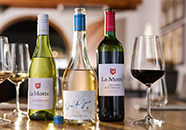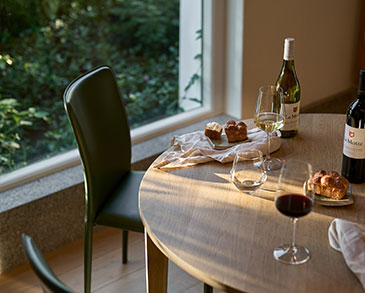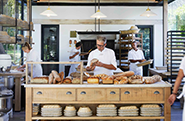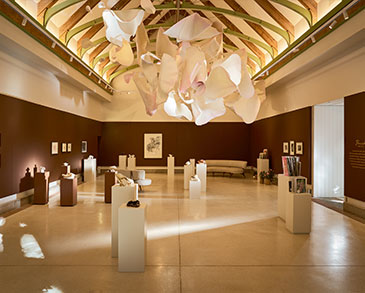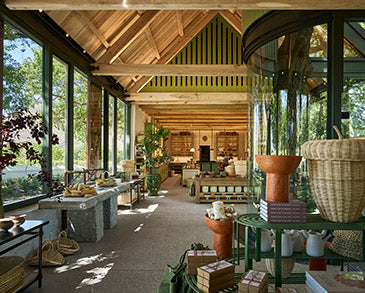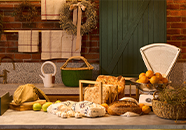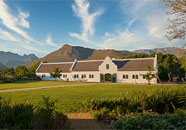The Kiss by Theo Megaw
The Kiss versinnebeeld moederlike liefde. Dit is op versoek van Hanneli Rupert-Koegelenberg geskep, en is op Vrouedag 2014 onthul. Die werk is geïnspireer deur moeders as rolmodelle vir hul kinders en die gemeenskap.
Op die vraag oor hoekom hy beeldhou, antwoord Theo: “Ek doen net, dit vloei net uit my hande voort. Ek sou kon sê dat ek daarvan hou om in die teenwoordigheid van soliede vorms te wees. Dit hou my gevestig en my hande hou van skep. En ek geniet dit om te beweeg terwyl ek werk. Ek hou daarvan om te buk, te rek, te hamer en te lig, en om heeldag op my voete te wees. Dit verg baie beweging om ’n gevoel van stilte uit ’n beeldhouwerk voort te bring. Die skeppende proses is vir my organies – ek streef daarna om gevoel te ontlok. Indien ’n kunsvorm nie emosie oordra nie, hetsy dit musiek, skilderkuns, skryfkuns of beeldhouwerk is, is dit vir my doelloos. Ek wil nie hê ’n aanskouer moet oor my beeldhouwerk hoef te dink nie, ek wil ʼn instinktiewe respons ontlok.
Ek vind inspirasie in wolkemassas en ligte wolkies. Om vars berglug in te asem. Sonlig op ’n growwe boomstam. Die kurwe van ’n nek tussen die skouer en oor. ’n Brahms-klarinet- en klaviersonate. Dit hoef nie visueel te wees nie. ’n Spesifieke vrou se liggaam. ’n Rooibok. Om myself toe te laat om innerlik stil te wees, om myself met die heelal te verbind. Soms duur die tydperk van stilte ’n dag, soms ’n week.
My gunsteling medium is die een waarin ek op die oomblik werk. Elke medium is reg vir ’n sekere gemoedstoestand, gevoel of ritme. Klei is die beste vir vinnige, vurige werk. Klip verg ’n stadiger, meer deurdagte benadering. Met staal moet alles bereken word. Hout het ’n sensualiteit in die kleur en tekstuur – bome wil lengte hê. Platheid hoort by klip. Met klip en hout beitel jy weg wat jy nie wil hê nie. Met klei is dit die teenoorgestelde: jy begin met niks en voeg by totdat jy iets het.”
Symbolising motherly love, The Kiss was commissioned by Mrs. Hanneli Rupert-Koegelenberg and unveiled on Women’s Day 2014. The work is inspired by mothers as role models for children and in society. The sculpture portrays genuine and subtle notes of care and love.
To the question of why he sculpts, Theo answers, “I just do. It comes out of me, through my hands. I suppose if I think about it, I could say I like being in the presence of solid form. It has a grounding effect. My hands like making. And I like moving while I work. I like bending and reaching and hammering and lifting and being on my feet all day. There’s a lot of movement needed to bring about the stillness of a piece of sculpture. Creating form for me is an organic process. I strive to evoke feeling. If it does not express feeling – any art form: music, painting, writing, sculpture – to me is nothing. I don’t want you to think about my sculpture. It’s a gut reaction I want.
(I find inspiration in) a mass of cloud, a wisp of cloud. Breathing fresh mountain air. Sunlight on a rough tree trunk. The curve in a neck between shoulder and ear. A Brahms clarinet and piano sonata. It doesn’t have to be visual. A particular woman’s body. An impala. Allowing myself to be inwardly quiet – to make my . . . call it my connection with the universe. Sometimes the period of quiet is a day, sometimes it’s a week.
My favourite medium is the one I’m working with at that moment. Each medium is right for a certain mood of work, a certain feel, a certain tempo. Clay is right for fast, fiery work. Stone, on the other hand, is right for a slow, ruminative approach; shall I make this a little more concave? Shall I make that a little more convex? With steel you work everything out – you calculate and cut and fit. Wood – you fall in love with the sensuousness of colour and grain and the feeling of longness – the tree wants longness. Squatness belongs to stone. With stone and wood, you chip away what you don’t want. With clay it’s the opposite. You start with nothing and add until you have what you want.”
Theo Megaw on sculpture, inspiration and medium. Extracts from an interview with Polly Anderson.
Text courtesy of Polly Anderson and Knysna Fine Art.

